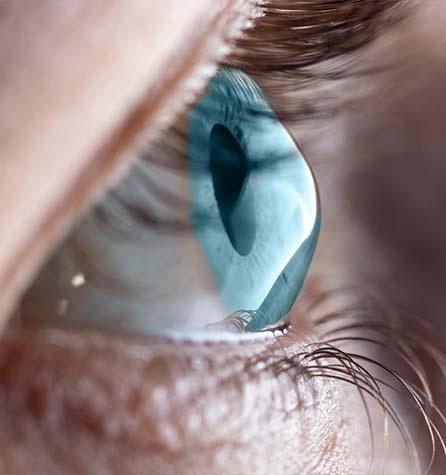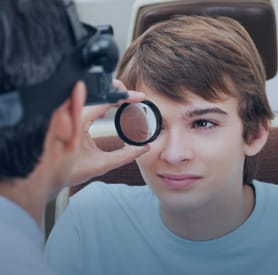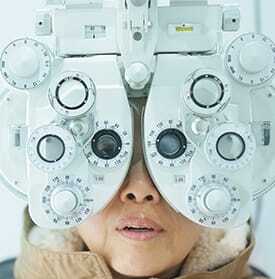Preserve Your Vision from Eye Disease
No doubt your health always occupies some space in your mind, whether you’re worried about eating healthy enough, exercising enough, or even just relaxing enough. And while your body needs to be looked after, your eyes need the same care and attention.
It’s no secret your eyes change as you age, but these changes can increase your risk of developing an eye disease or condition without your knowledge. Some of these issues are so subtle that only a comprehensive eye exam can detect them before you experience vision loss.
We want to help you preserve your vision, and the first step on this journey is an eye exam. Book your next appointment with us today!
Common Eye Diseases & Conditions
The risk of developing an eye disease or condition varies from person to person. Like a family history of eye disease or diabetes, certain health issues can increase the risk of developing these issues.
We can help provide answers for all of your eye-related questions and provide treatment options depending on your particular issue.
Some of the most common eye issues our patients experience include:
Glaucoma
Glaucoma is a group of diseases that can damage the optic nerve. In most cases, glaucoma occurs when your intraocular pressure (IOP) rises over time, but it can still develop even if your IOP levels are within normal limits.
The 3 most common types of glaucoma include:
Open-Angle Glaucoma
Open-angle glaucoma is the most common type of glaucoma, occurring when your IOP rises slowly over a long period. It occurs when your eye’s natural draining system is compromised, but the drainage angle between your iris and pupil remains open. When this happens, your intraocular fluids can’t drain properly.
Open-angle glaucoma can develop without noticeable symptoms during its early stages. However, as your IOP levels increase, it can damage your optic nerve, leading to permanent vision loss.
Your risk of developing open-angle glaucoma increases if you have a family history of the disease, or have diabetes or heart disease, or if you’re African-American or Latino.
Closed-Angle Glaucoma
Closed-angle glaucoma, or angle-closure glaucoma, is not as common as open-angle glaucoma, but it can be far more dangerous for your vision. This disease occurs when the drainage angle between your iris and pupil closes suddenly, resulting in a rapid increase in IOP levels.
As your IOP levels rise, you may start to experience nausea, headaches, red eyes, eye pain, or sudden vision loss. Because of this, we consider closed-angle glaucoma a medical emergency and recommend immediate assistance.
Normal-Tension Glaucoma
While other types of glaucoma occur when your IOP levels rise, normal-tension glaucoma develops when your IOP levels are within a normal range. Doctors aren’t quite sure how this disease develops, but we can detect it during a comprehensive eye exam.
Age-Related Macular Degeneration
Age-related macular degeneration is one of the most common eye diseases that affect adults over 55.
As you grow older, AMD can deteriorate your macula, a part of your retina that provides your central vision. As the disease progresses, it can make it difficult for you to read, drive, see fine details, or recognize faces.
Smoking, obesity, diabetes, and a family history of AMD can all increase the risk of developing this disease.
There are 2 different types of this disease, both of which we can detect during a comprehensive eye exam:
Dry AMD
Dry AMD is the most common version. Dry AMD occurs when your macula slowly thins as you age, eventually leading to central vision problems or vision loss.
While doctors aren’t quite sure how this disease develops, some believe there’s a link between macular degeneration and the presence of a lipid called drusen. Drusen can form under your macula as you age, possibly contributing to AMD.
Wet AMD
Wet AMD is responsible for 90% of all AMD-related blindness and can occur if abnormal blood vessels break and leak fluid underneath the macula. Wet AMD always begins as dry AMD, but wet AMD can develop much quicker and lead to sudden vision loss.
Wet AMD is considered a medical emergency that requires medical attention.
Diabetic Eye Diseases
Diabetes can increase the risk of developing various eye diseases, but some of the most common include diabetic retinopathy and diabetic macular edema.
High blood sugar can damage your retina’s blood vessels, causing them to bulge, break, and leak fluid into your retina. Both diabetic retinopathy and diabetic macular edema can develop without early symptoms, but they can eventually cause permanent vision loss.
To learn more about diabetes and the effect it can have on your vision, please visit our Diabetic Eye Exams page.
Cataracts
Cataracts are an eye condition that most people develop as they age. As you grow older, proteins on your eye’s lens can clump together, causing your natural lens to become rigid and opaque.
As your lens changes, it can develop a milky, hazy color that can make it difficult for you to see clearly. Glasses or contact lenses can correct early vision problems caused by cataracts, but the only way to remove a cataract is through surgery.
Cataracts are the leading cause of blindness in the United States and worldwide.
Conjunctivitis
Conjunctivitis, commonly known as pink eye, is an eye infection that can develop for various reasons. It affects your eye’s conjunctiva, a transparent membrane that lines your eyes and inner eyelids.
Conjunctivitis can be caused by viruses or bacteria, allergies, or chemical exposure.
Each type of pink eye can present with similar symptoms, including:
- Irritation
- Redness
- Discharge
- Wateriness
- Crustiness
If your symptoms are caused by chemical exposure, it is a medical emergency that requires immediate attention. Please flush your eyes with cool, clean water for 15 minutes and call our team immediately.


Take a Look into Your Eye Health Today
Preserving your eye health starts with a comprehensive eye exam. Book your next appointment with the team at Griffin Optometric Group and discover the meaning of quality eye care.
Come See What We’re All About
Visit Us Today
You can easily find us right next to US Bank and across the street from Denault’s Ace Hardware.
Where To Park?
Free parking is plentiful around our practice.
Our Address
- 30030 Town Center Drive
- Laguna Niguel, CA 92677
Contact Information
- Phone: (949) 495-3031
- Email: [email protected]
Hours of Operation
- Monday: 8:00 AM – 5:00 PM
- Tuesday: 8:00 AM – 5:00 PM
- Wednesday: 8:00 AM – 5:00 PM
- Thursday: 8:00 AM – 5:00 PM
- Friday: 8:00 AM – 5:00 PM
- Saturday: Closed
- Sunday: Closed
Our Services

Adult & Senior Eye Exams

Children’s Eye Exams

Contact Lens Exams, Fittings, & Brands

Eye Disease Diagnosis & Management
Our Brands




Our Google Reviews
Be the First to Know,
Be the First to Win.
From eye health insights to exclusive giveaways, your feed just got a lot clearer.




